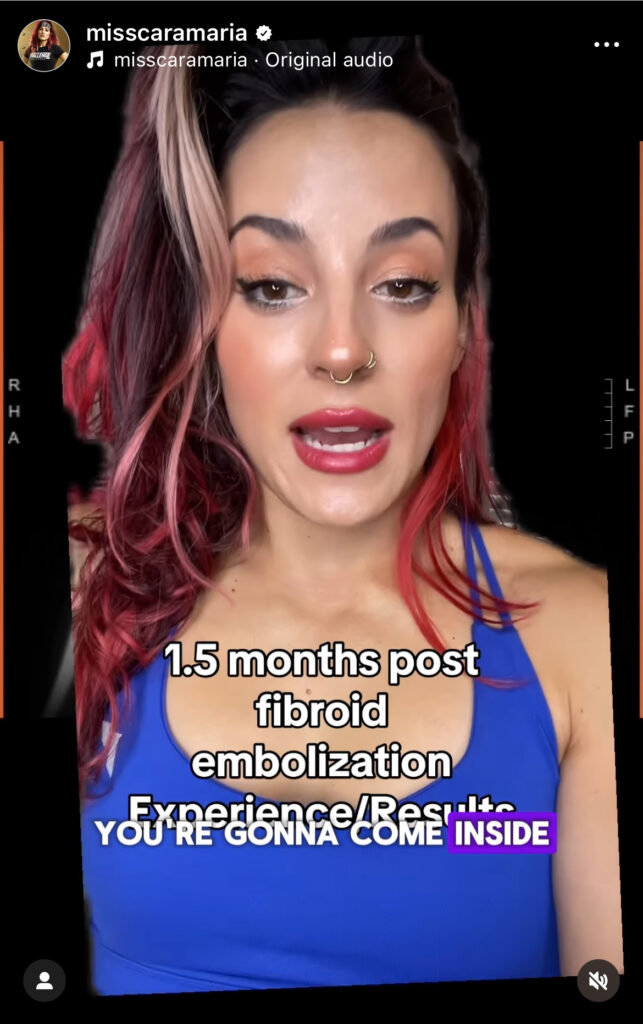Recently, we discovered a video from content creator Miss Cara Maria sharing her post-UFE experience with the White Dress Project’s Instagram account. (For those who don’t know, the White Dress Project—founded by Tanika Gray Valburn—was established to spread fibroid awareness, so that one day, even women who suffer from fibroid symptoms such as heavy periods can find relief, and then feel comfortable wearing white dresses at any time of the month.
Now, when it comes to finding fibroid relief, you have options. And many women want to know what life will look life in the weeks and months following their UFE treatment in Houston, TX. So, today, we’re sharing highlights from this real-life account of the post-treatment recovery period. That way, you can hear first-hand experiences to become a bit more familiar with how this minimally-invasive procedure will impact your fibroids.

In this Instagram video, the content creator reveals that she underwent the UFE treatment 1.5 months earlier. She sought treatment for a uterine fibroid that had grown to 16 cm. She shared that, prior to treatment, people often asked her if she was pregnant. And that’s because the large tumor had caused her uterus to expand to a size similarly seen in women who are four months pregnant.
Initially, she believed that myomectomy surgery—preceded by six months of menopause-inducing hormones to keep the tumor from growing larger—was her only treatment option. Naturally, she wanted to avoid such an invasive option if at all possible. Luckily, she discovered that she was a candidate for fibroid embolization, and that made all the difference in her treatment and recovery story.
As Cara Maria explained, uterine fibroid embolization (or UFE) helps shrink the fibroid tumors by blocking blood flow to the arteries feeding the fibroid only. This will cause the fibroids to shrink over the next 3 months to 1 year. She also realized that the procedure was “in and out, with no long recovery period.” And, once the procedure was complete, she could really see the impact UFE had on her massive fibroid.
Cara revealed that she underwent UFE on a Monday, and the initial period afterward was “brutal,” mostly, she admits, because she didn’t take her prescribed pain medication, and experienced a buildup of gas following the procedure. However, by Friday she was feeling much better—and that’s a much faster turnaround time than you could expect with surgical options.
A week after the procedure, she was able to start exercising although she “took it easy” for a few weeks, compared to her typical two-a-day workouts. And now, 1.5 months after UFE, she says, “I’m doing amazing. I feel great.” The feelings of bloating and fullness that she experienced prior to her procedure are slowly going away. She does still notice some bleeding that requires a daily tampon but not the flow of normal cycle. She is aware that this is from the ‘dying off’ fibroid. This is expected for the first 3 months and considered normal.
And what about the fibroid itself? How much has it shrunk? Well, at 1.5 months after UFE, the tumor is still shrinking. Visually, she notes, you don’t see much of a difference in terms of the reduced fibroid size. Shrinking of fibroid is measured by patient improvement as this is the primary goal. Cara reports she’ll have a follow up scan 6 months after the UFE procedure, where she can expect to see a tumor that’s drastically reduced in size. However, she states that she can feel a major difference in her body which has dramatically improved her quality of life even before the full effects of the procedure have been appreciated.
Like Cara, are you in need of fibroid relief but hope to avoid an invasive surgery? Our fibroid specialists in Houston are ready to review your treatment options, and help determine if you’re a candidate for UFE. Click here to request a consultation.
As leading fibroid specialists in Houston, we can help you get back to doing the things you love – free of pain and symptoms associated with this diagnosis.

Scheduling
Please contact our dedicated specialists to schedule a consultation today.
2025 Houston Fibroids. All rights reserved. Website Design by Healthcare Success